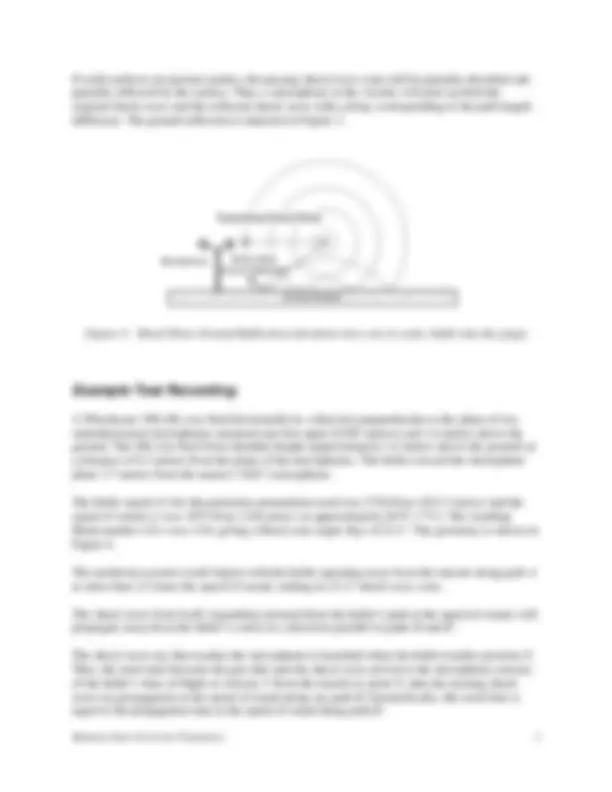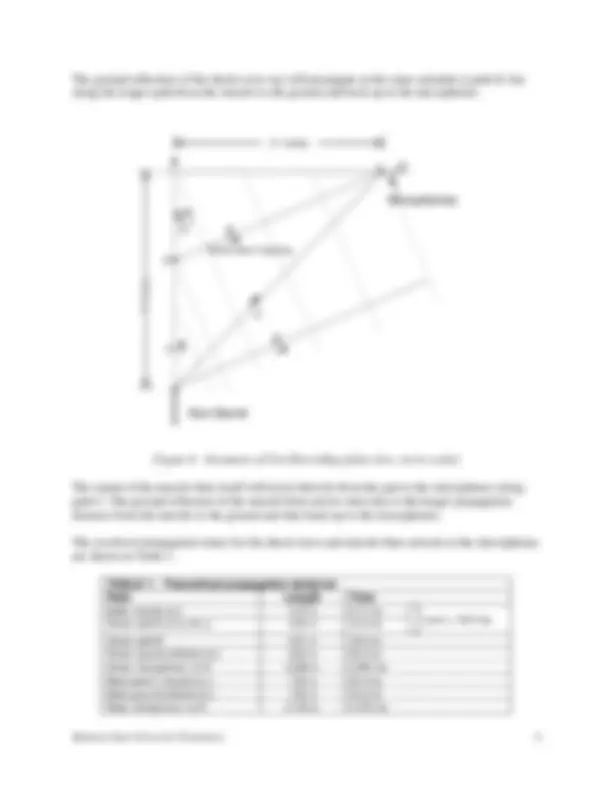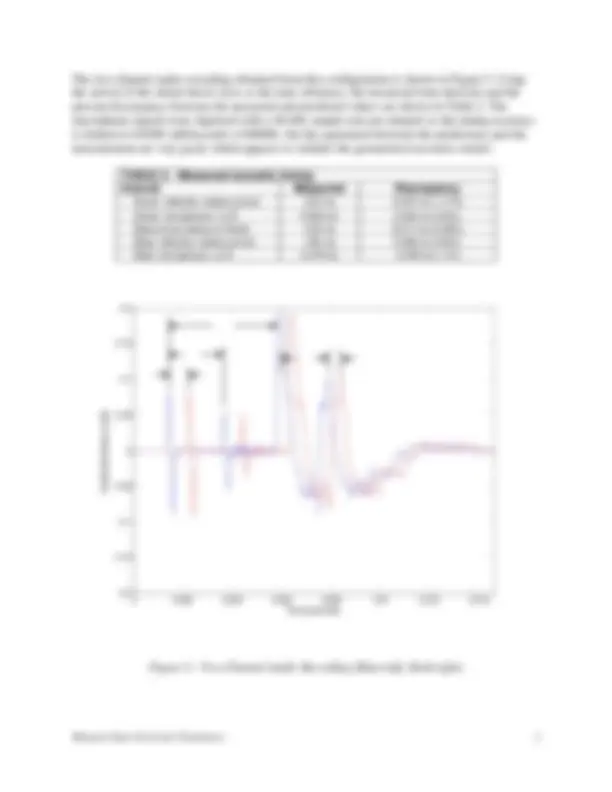





Study with the several resources on Docsity

Earn points by helping other students or get them with a premium plan


Prepare for your exams
Study with the several resources on Docsity

Earn points to download
Earn points by helping other students or get them with a premium plan
Community
Ask the community for help and clear up your study doubts
Discover the best universities in your country according to Docsity users
Free resources
Download our free guides on studying techniques, anxiety management strategies, and thesis advice from Docsity tutors
A summary of gun shot acoustics and how audio recordings of gun shots can provide information about the gun location, speed, and trajectory of the projectile. the difficulties in interpreting such recordings due to reverberation and overlapping acoustic signal reflections. It also discusses the muzzle blast and supersonic projectiles, including the shock wave considerations. a detailed description of the acoustic shock wave from the bullet and how it propagates. useful for students studying acoustics, physics, and ballistics.
Typology: Lecture notes
1 / 7

This page cannot be seen from the preview
Don't miss anything!




Robert C. Maher, Montana State University 4 April 2006
Audio recordings of gun shots can provide information about the gun location with respect to the microphone(s) and the speed and trajectory of the projectile. The principal difficulty when interpreting such recordings arises from reverberation (overlapping acoustic signal reflections) due to the gun shot sound reflecting off and diffracting around nearby surfaces.
A conventional firearm uses a confined explosive charge to propel the bullet out of the gun barrel. The hot, rapidly expanding gases cause an acoustic blast to emerge from the barrel. The acoustic disturbance lasts 3-5 milliseconds and propagates through the air at the speed of sound ( c ). The sound level of the muzzle blast is strongest in the direction the barrel is pointing, and decreases as the off-axis angle increases.
A microphone located in the vicinity of the gun shot will detect the muzzle blast signal once the sound propagation travels at the speed of sound from the gun to the microphone position. However, the muzzle blast signal will also reflect off the ground and off other nearby surfaces, resulting in a complicated received signal consisting of multiple overlapping reflections.
Depending on the size of the charge, the mass of the bullet, and other factors, the bullet may be traveling at supersonic speed. A supersonic bullet causes a characteristic shock wave pattern as it moves through the air. The shock wave expands as a cone behind the bullet, with the wave front propagating outward at the speed of sound. The shock wave cone has an inner angle, θ M = arcsin(1/ M ), where M = V / c is the Mach Number. The geometry is shown in Figure 1.
With a very fast bullet, M is large and θ M becomes small, causing the shock wave to propagate nearly perpendicularly to the bullet's trajectory. For example, a bullet traveling at 3000 feet per second at room temperature has M =2.67, giving θ M = ~22°. On the other hand, if the bullet is only slightly faster than the speed of sound, M is approximately unity, θ M is nearly 90°, and the shock wave propagates nearly parallel to the bullet's path.
If two or more microphones are located at known locations within the path of the shock wave, the time of arrival difference(s) can be used to estimate the shock's propagation direction. Note, however, that determining the bullet's trajectory from the shock propagation vector requires knowledge of the bullet velocity, V. If V is not known, then M and θ M are also not known, and the bullet's trajectory cannot be determined exactly without additional spatial information.
Figure 1: Supersonic Bullet Shock Wave Description
The acoustic shock wave from the bullet has a very rapid rise to a positive overpressure maximum, followed by a corresponding under-pressure minimum. As the shock wave propagates the nonlinear behavior of the air causes the pressure disturbance to form an "N" shape with a rapid onset, a ramp to the minimum pressure, and then an abrupt offset. The time interval of the "N" wave between the over- and under-pressure is proportional to the size of the projectile. A typical bullet a few centimeters long has an intershock interval of less than 200 μsec, as shown in Figure 2.
Figure 2: Shock Wave Recording (“N” Wave)
Bullet Trajectory
Shockwave Cone
(velocity V )
Shock Wave Front Trajectory (velocity c )
θ M
c
M
arcsin
Machnumber
θ
Microphones
0 0.1 0.2 0.3 0.4 0.5 0.6 0.7 0.8 0.9 1
-0.
-0.
-0.
-0.
0
Time [milliseconds]
Amplitude [normalized linear scale]
The ground reflection of the shock wave ray will propagate at the same azimuth as path B , but along the longer path from the muzzle to the ground and back up to the microphones.
Figure 4: Geometry of Test Recording (plan view, not to scale)
The sound of the muzzle blast itself will travel directly from the gun to the microphones along path C. The ground reflection of the muzzle blast arrives later due to the longer propagation distance from the muzzle to the ground and then back up to the microphones.
The predicted propagation times for the shock wave and muzzle blast arrivals at the microphones are shown in Table 1.
TABLE 1: Theoretical propagation behavior Path Length Time Bullet: muzzle to X 4.75 m 5.71 ms Shock: path B ( X to mic L ) 4.35 m 12.3 ms Shock: path B ’ 5.91 m 18.0 ms Shock: ground reflection to L 6.63 m 20.2 ms Shock: microphone L to R 0.280 m 0.855 ms Blast: path C (muzzle to L ) 7.35 m 22.4 ms Blast: ground reflection to L 7.93 m 24.2 ms Blast: microphone L to R 0.154 m 0.470 ms
sum = 1 8.0 ms
Gun Barrel
Shock Wave Trajectory
3.7 meters
6.
meters
θ M = 23°
Microphones
L R
The two-channel audio recording obtained from this configuration is shown in Figure 5. Using the arrival of the initial shock wave as the time reference, the measured time intervals and the percent discrepancy between the measured and predicted values are shown in Table 2. The microphone signals were digitized with a 48 kHz sample rate per channel so the timing accuracy is limited to 0.0208 milliseconds (1/48000), but the agreement between the predictions and the measurement are very good, which appears to validate the geometrical acoustics model.
TABLE 2: Measured acoustic timing Interval Measured Discrepancy
Figure 5: Two-Channel Audio Recording (Blue=left, Red=right)
0 0.002 0.004 0.006 0.008 0.01 0.012 0. -0.
-0.
-0.
-0.
0
Time [seconds]
Amplitude [linear scale]
Figure 8: Hand Gun Recording (same position as rifle data in Figure 4 and Figure 5)